Examining Passion, Rebellion, and Identity in Popular Music Essay
VerifiedAdded on 2023/06/04
|7
|2407
|171
Essay
AI Summary
This essay critically examines the assertion that 'there is no such thing as extreme music,' arguing that the categorization of music is subjective and based on individual taste. It explores the characteristics of extreme music, often associated with heavy metal subgenres, and contrasts its perceived abrasiveness with its potential positive impacts. The essay references studies indicating that extreme music can help listeners process anger, regulate emotions, and enhance well-being. It challenges the notion that extreme music is inherently negative, suggesting that its classification is rooted in personal perception rather than an objective measure of its impact. The essay concludes that music, regardless of genre, serves as a form of expression and can provide relief and motivation, emphasizing that the perceived 'extremeness' of music lies in the listener's interpretation and connection to it. Desklib offers access to similar essays and study resources for students.

RUNNING HEAD: Passion, Rebellion, and Identity in Popular music
Passion, Rebellion, and Identity in Popular music
[Type the document subtitle]
Laptop04011
[Pick the date]
Passion, Rebellion, and Identity in Popular music
[Type the document subtitle]
Laptop04011
[Pick the date]
Paraphrase This Document
Need a fresh take? Get an instant paraphrase of this document with our AI Paraphraser
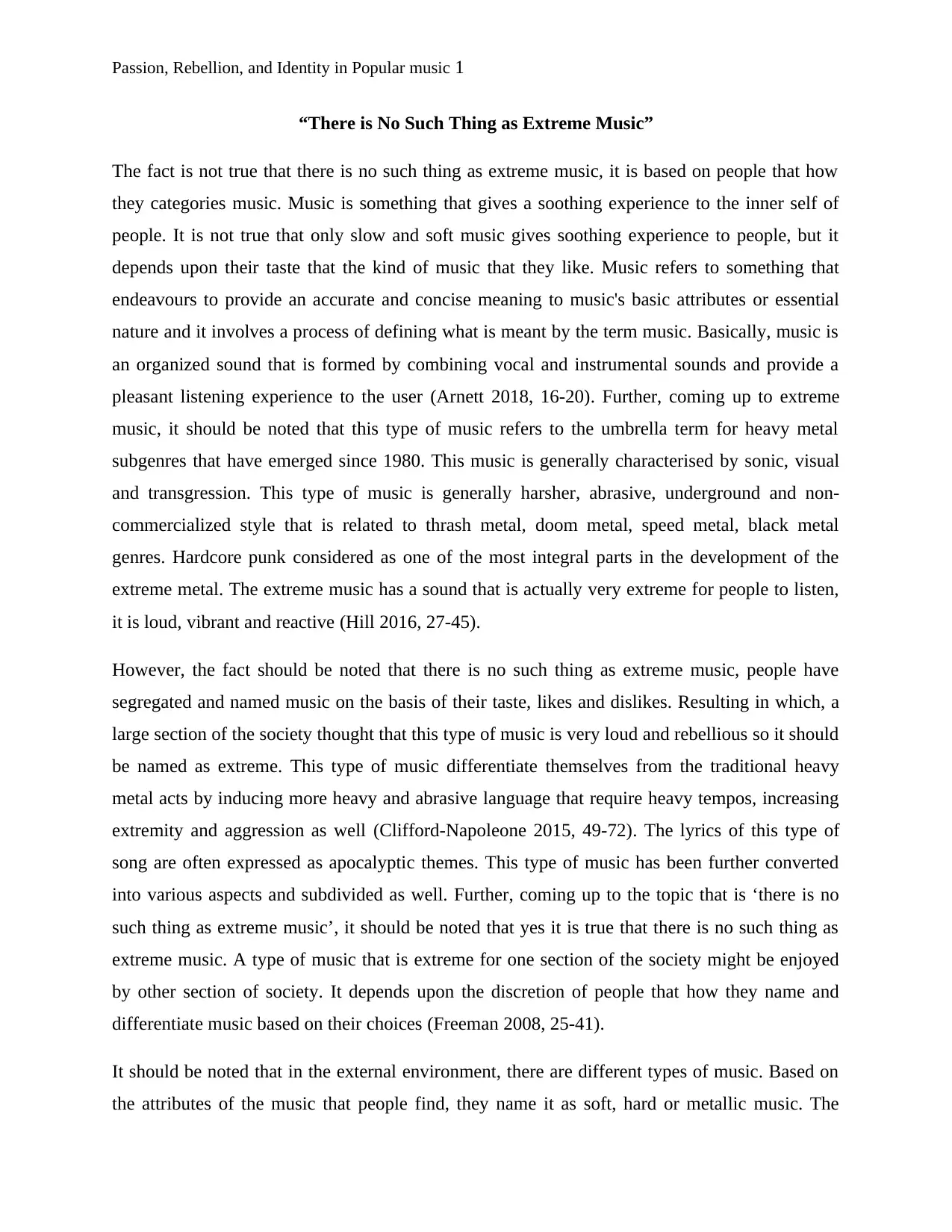
Passion, Rebellion, and Identity in Popular music 1
“There is No Such Thing as Extreme Music”
The fact is not true that there is no such thing as extreme music, it is based on people that how
they categories music. Music is something that gives a soothing experience to the inner self of
people. It is not true that only slow and soft music gives soothing experience to people, but it
depends upon their taste that the kind of music that they like. Music refers to something that
endeavours to provide an accurate and concise meaning to music's basic attributes or essential
nature and it involves a process of defining what is meant by the term music. Basically, music is
an organized sound that is formed by combining vocal and instrumental sounds and provide a
pleasant listening experience to the user (Arnett 2018, 16-20). Further, coming up to extreme
music, it should be noted that this type of music refers to the umbrella term for heavy metal
subgenres that have emerged since 1980. This music is generally characterised by sonic, visual
and transgression. This type of music is generally harsher, abrasive, underground and non-
commercialized style that is related to thrash metal, doom metal, speed metal, black metal
genres. Hardcore punk considered as one of the most integral parts in the development of the
extreme metal. The extreme music has a sound that is actually very extreme for people to listen,
it is loud, vibrant and reactive (Hill 2016, 27-45).
However, the fact should be noted that there is no such thing as extreme music, people have
segregated and named music on the basis of their taste, likes and dislikes. Resulting in which, a
large section of the society thought that this type of music is very loud and rebellious so it should
be named as extreme. This type of music differentiate themselves from the traditional heavy
metal acts by inducing more heavy and abrasive language that require heavy tempos, increasing
extremity and aggression as well (Clifford-Napoleone 2015, 49-72). The lyrics of this type of
song are often expressed as apocalyptic themes. This type of music has been further converted
into various aspects and subdivided as well. Further, coming up to the topic that is ‘there is no
such thing as extreme music’, it should be noted that yes it is true that there is no such thing as
extreme music. A type of music that is extreme for one section of the society might be enjoyed
by other section of society. It depends upon the discretion of people that how they name and
differentiate music based on their choices (Freeman 2008, 25-41).
It should be noted that in the external environment, there are different types of music. Based on
the attributes of the music that people find, they name it as soft, hard or metallic music. The
“There is No Such Thing as Extreme Music”
The fact is not true that there is no such thing as extreme music, it is based on people that how
they categories music. Music is something that gives a soothing experience to the inner self of
people. It is not true that only slow and soft music gives soothing experience to people, but it
depends upon their taste that the kind of music that they like. Music refers to something that
endeavours to provide an accurate and concise meaning to music's basic attributes or essential
nature and it involves a process of defining what is meant by the term music. Basically, music is
an organized sound that is formed by combining vocal and instrumental sounds and provide a
pleasant listening experience to the user (Arnett 2018, 16-20). Further, coming up to extreme
music, it should be noted that this type of music refers to the umbrella term for heavy metal
subgenres that have emerged since 1980. This music is generally characterised by sonic, visual
and transgression. This type of music is generally harsher, abrasive, underground and non-
commercialized style that is related to thrash metal, doom metal, speed metal, black metal
genres. Hardcore punk considered as one of the most integral parts in the development of the
extreme metal. The extreme music has a sound that is actually very extreme for people to listen,
it is loud, vibrant and reactive (Hill 2016, 27-45).
However, the fact should be noted that there is no such thing as extreme music, people have
segregated and named music on the basis of their taste, likes and dislikes. Resulting in which, a
large section of the society thought that this type of music is very loud and rebellious so it should
be named as extreme. This type of music differentiate themselves from the traditional heavy
metal acts by inducing more heavy and abrasive language that require heavy tempos, increasing
extremity and aggression as well (Clifford-Napoleone 2015, 49-72). The lyrics of this type of
song are often expressed as apocalyptic themes. This type of music has been further converted
into various aspects and subdivided as well. Further, coming up to the topic that is ‘there is no
such thing as extreme music’, it should be noted that yes it is true that there is no such thing as
extreme music. A type of music that is extreme for one section of the society might be enjoyed
by other section of society. It depends upon the discretion of people that how they name and
differentiate music based on their choices (Freeman 2008, 25-41).
It should be noted that in the external environment, there are different types of music. Based on
the attributes of the music that people find, they name it as soft, hard or metallic music. The
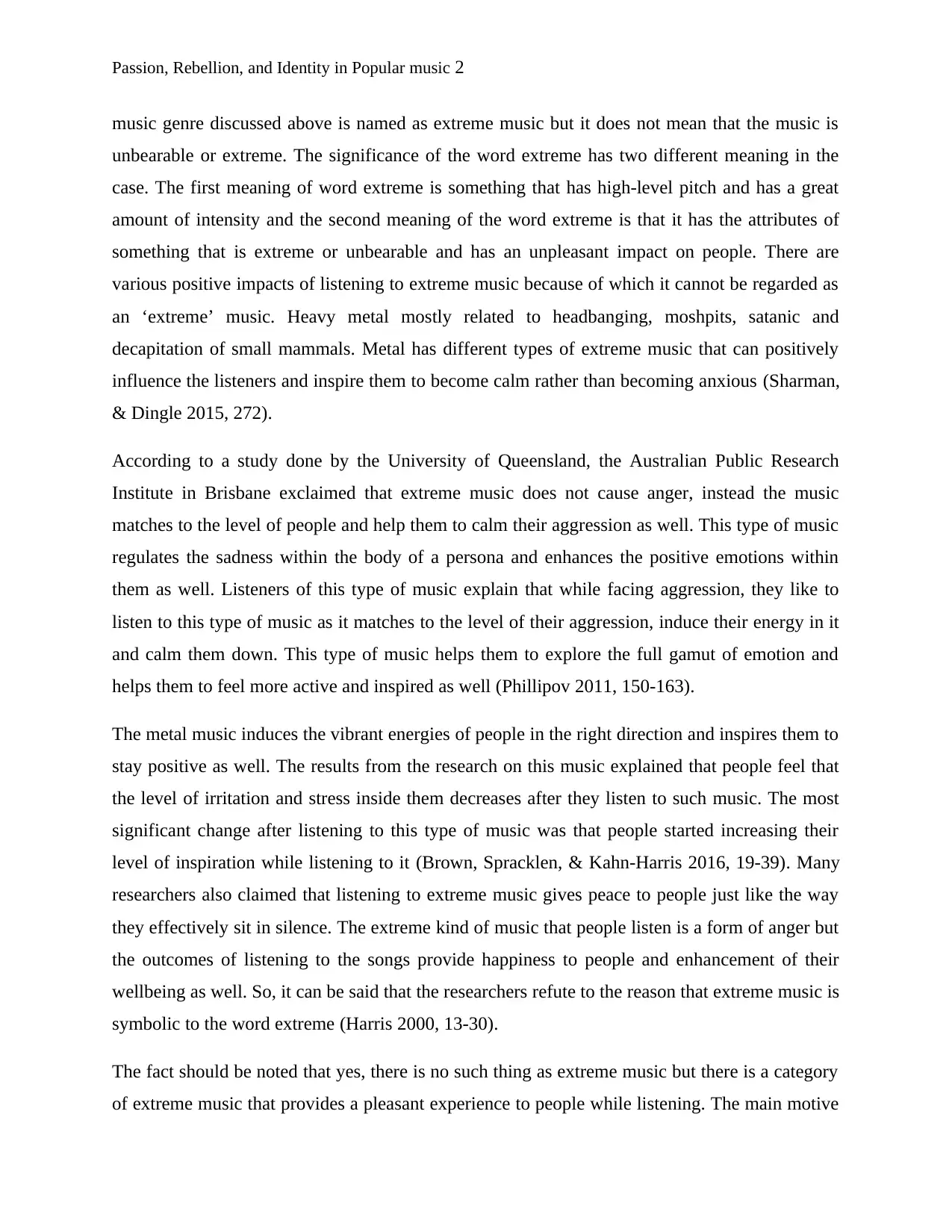
Passion, Rebellion, and Identity in Popular music 2
music genre discussed above is named as extreme music but it does not mean that the music is
unbearable or extreme. The significance of the word extreme has two different meaning in the
case. The first meaning of word extreme is something that has high-level pitch and has a great
amount of intensity and the second meaning of the word extreme is that it has the attributes of
something that is extreme or unbearable and has an unpleasant impact on people. There are
various positive impacts of listening to extreme music because of which it cannot be regarded as
an ‘extreme’ music. Heavy metal mostly related to headbanging, moshpits, satanic and
decapitation of small mammals. Metal has different types of extreme music that can positively
influence the listeners and inspire them to become calm rather than becoming anxious (Sharman,
& Dingle 2015, 272).
According to a study done by the University of Queensland, the Australian Public Research
Institute in Brisbane exclaimed that extreme music does not cause anger, instead the music
matches to the level of people and help them to calm their aggression as well. This type of music
regulates the sadness within the body of a persona and enhances the positive emotions within
them as well. Listeners of this type of music explain that while facing aggression, they like to
listen to this type of music as it matches to the level of their aggression, induce their energy in it
and calm them down. This type of music helps them to explore the full gamut of emotion and
helps them to feel more active and inspired as well (Phillipov 2011, 150-163).
The metal music induces the vibrant energies of people in the right direction and inspires them to
stay positive as well. The results from the research on this music explained that people feel that
the level of irritation and stress inside them decreases after they listen to such music. The most
significant change after listening to this type of music was that people started increasing their
level of inspiration while listening to it (Brown, Spracklen, & Kahn-Harris 2016, 19-39). Many
researchers also claimed that listening to extreme music gives peace to people just like the way
they effectively sit in silence. The extreme kind of music that people listen is a form of anger but
the outcomes of listening to the songs provide happiness to people and enhancement of their
wellbeing as well. So, it can be said that the researchers refute to the reason that extreme music is
symbolic to the word extreme (Harris 2000, 13-30).
The fact should be noted that yes, there is no such thing as extreme music but there is a category
of extreme music that provides a pleasant experience to people while listening. The main motive
music genre discussed above is named as extreme music but it does not mean that the music is
unbearable or extreme. The significance of the word extreme has two different meaning in the
case. The first meaning of word extreme is something that has high-level pitch and has a great
amount of intensity and the second meaning of the word extreme is that it has the attributes of
something that is extreme or unbearable and has an unpleasant impact on people. There are
various positive impacts of listening to extreme music because of which it cannot be regarded as
an ‘extreme’ music. Heavy metal mostly related to headbanging, moshpits, satanic and
decapitation of small mammals. Metal has different types of extreme music that can positively
influence the listeners and inspire them to become calm rather than becoming anxious (Sharman,
& Dingle 2015, 272).
According to a study done by the University of Queensland, the Australian Public Research
Institute in Brisbane exclaimed that extreme music does not cause anger, instead the music
matches to the level of people and help them to calm their aggression as well. This type of music
regulates the sadness within the body of a persona and enhances the positive emotions within
them as well. Listeners of this type of music explain that while facing aggression, they like to
listen to this type of music as it matches to the level of their aggression, induce their energy in it
and calm them down. This type of music helps them to explore the full gamut of emotion and
helps them to feel more active and inspired as well (Phillipov 2011, 150-163).
The metal music induces the vibrant energies of people in the right direction and inspires them to
stay positive as well. The results from the research on this music explained that people feel that
the level of irritation and stress inside them decreases after they listen to such music. The most
significant change after listening to this type of music was that people started increasing their
level of inspiration while listening to it (Brown, Spracklen, & Kahn-Harris 2016, 19-39). Many
researchers also claimed that listening to extreme music gives peace to people just like the way
they effectively sit in silence. The extreme kind of music that people listen is a form of anger but
the outcomes of listening to the songs provide happiness to people and enhancement of their
wellbeing as well. So, it can be said that the researchers refute to the reason that extreme music is
symbolic to the word extreme (Harris 2000, 13-30).
The fact should be noted that yes, there is no such thing as extreme music but there is a category
of extreme music that provides a pleasant experience to people while listening. The main motive
⊘ This is a preview!⊘
Do you want full access?
Subscribe today to unlock all pages.

Trusted by 1+ million students worldwide
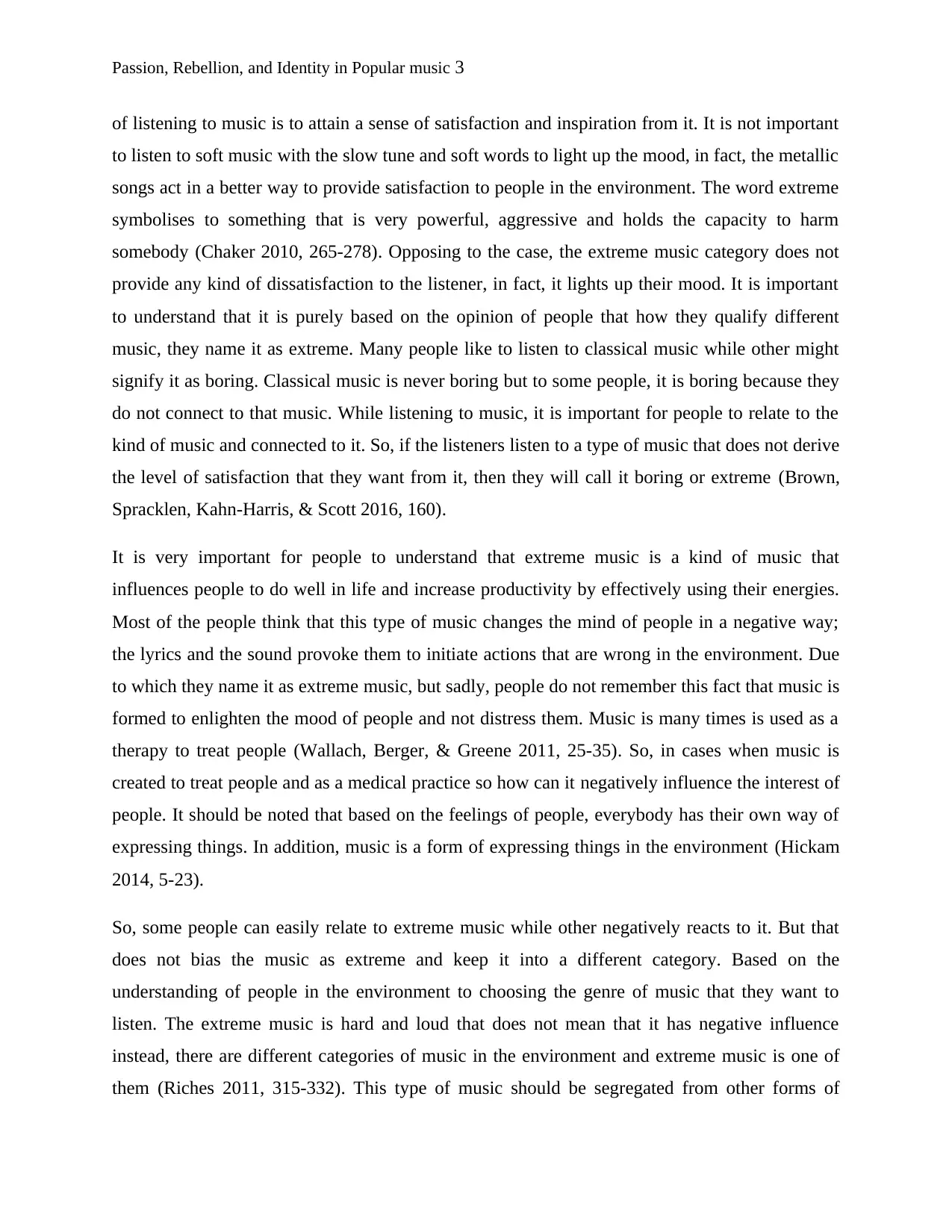
Passion, Rebellion, and Identity in Popular music 3
of listening to music is to attain a sense of satisfaction and inspiration from it. It is not important
to listen to soft music with the slow tune and soft words to light up the mood, in fact, the metallic
songs act in a better way to provide satisfaction to people in the environment. The word extreme
symbolises to something that is very powerful, aggressive and holds the capacity to harm
somebody (Chaker 2010, 265-278). Opposing to the case, the extreme music category does not
provide any kind of dissatisfaction to the listener, in fact, it lights up their mood. It is important
to understand that it is purely based on the opinion of people that how they qualify different
music, they name it as extreme. Many people like to listen to classical music while other might
signify it as boring. Classical music is never boring but to some people, it is boring because they
do not connect to that music. While listening to music, it is important for people to relate to the
kind of music and connected to it. So, if the listeners listen to a type of music that does not derive
the level of satisfaction that they want from it, then they will call it boring or extreme (Brown,
Spracklen, Kahn-Harris, & Scott 2016, 160).
It is very important for people to understand that extreme music is a kind of music that
influences people to do well in life and increase productivity by effectively using their energies.
Most of the people think that this type of music changes the mind of people in a negative way;
the lyrics and the sound provoke them to initiate actions that are wrong in the environment. Due
to which they name it as extreme music, but sadly, people do not remember this fact that music is
formed to enlighten the mood of people and not distress them. Music is many times is used as a
therapy to treat people (Wallach, Berger, & Greene 2011, 25-35). So, in cases when music is
created to treat people and as a medical practice so how can it negatively influence the interest of
people. It should be noted that based on the feelings of people, everybody has their own way of
expressing things. In addition, music is a form of expressing things in the environment (Hickam
2014, 5-23).
So, some people can easily relate to extreme music while other negatively reacts to it. But that
does not bias the music as extreme and keep it into a different category. Based on the
understanding of people in the environment to choosing the genre of music that they want to
listen. The extreme music is hard and loud that does not mean that it has negative influence
instead, there are different categories of music in the environment and extreme music is one of
them (Riches 2011, 315-332). This type of music should be segregated from other forms of
of listening to music is to attain a sense of satisfaction and inspiration from it. It is not important
to listen to soft music with the slow tune and soft words to light up the mood, in fact, the metallic
songs act in a better way to provide satisfaction to people in the environment. The word extreme
symbolises to something that is very powerful, aggressive and holds the capacity to harm
somebody (Chaker 2010, 265-278). Opposing to the case, the extreme music category does not
provide any kind of dissatisfaction to the listener, in fact, it lights up their mood. It is important
to understand that it is purely based on the opinion of people that how they qualify different
music, they name it as extreme. Many people like to listen to classical music while other might
signify it as boring. Classical music is never boring but to some people, it is boring because they
do not connect to that music. While listening to music, it is important for people to relate to the
kind of music and connected to it. So, if the listeners listen to a type of music that does not derive
the level of satisfaction that they want from it, then they will call it boring or extreme (Brown,
Spracklen, Kahn-Harris, & Scott 2016, 160).
It is very important for people to understand that extreme music is a kind of music that
influences people to do well in life and increase productivity by effectively using their energies.
Most of the people think that this type of music changes the mind of people in a negative way;
the lyrics and the sound provoke them to initiate actions that are wrong in the environment. Due
to which they name it as extreme music, but sadly, people do not remember this fact that music is
formed to enlighten the mood of people and not distress them. Music is many times is used as a
therapy to treat people (Wallach, Berger, & Greene 2011, 25-35). So, in cases when music is
created to treat people and as a medical practice so how can it negatively influence the interest of
people. It should be noted that based on the feelings of people, everybody has their own way of
expressing things. In addition, music is a form of expressing things in the environment (Hickam
2014, 5-23).
So, some people can easily relate to extreme music while other negatively reacts to it. But that
does not bias the music as extreme and keep it into a different category. Based on the
understanding of people in the environment to choosing the genre of music that they want to
listen. The extreme music is hard and loud that does not mean that it has negative influence
instead, there are different categories of music in the environment and extreme music is one of
them (Riches 2011, 315-332). This type of music should be segregated from other forms of
Paraphrase This Document
Need a fresh take? Get an instant paraphrase of this document with our AI Paraphraser
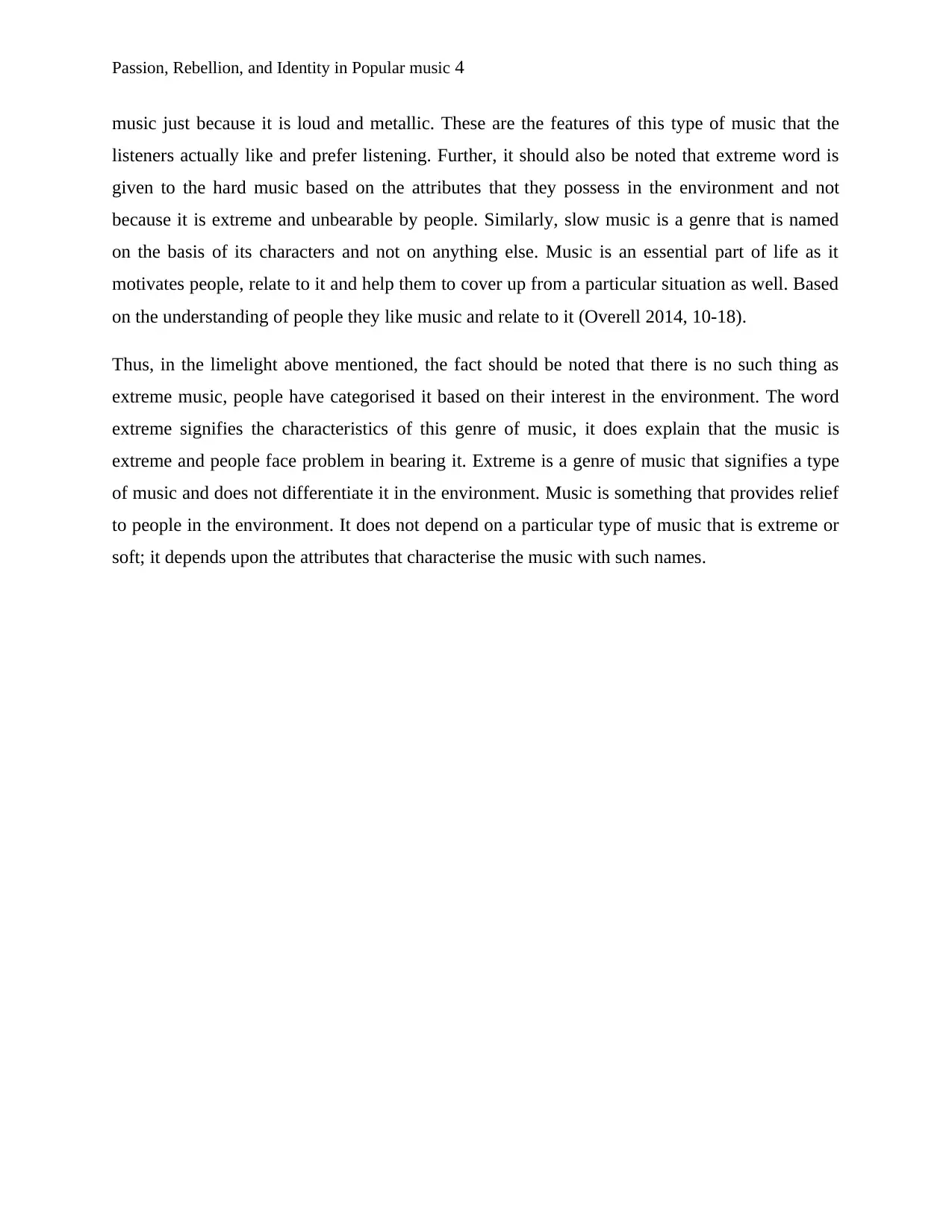
Passion, Rebellion, and Identity in Popular music 4
music just because it is loud and metallic. These are the features of this type of music that the
listeners actually like and prefer listening. Further, it should also be noted that extreme word is
given to the hard music based on the attributes that they possess in the environment and not
because it is extreme and unbearable by people. Similarly, slow music is a genre that is named
on the basis of its characters and not on anything else. Music is an essential part of life as it
motivates people, relate to it and help them to cover up from a particular situation as well. Based
on the understanding of people they like music and relate to it (Overell 2014, 10-18).
Thus, in the limelight above mentioned, the fact should be noted that there is no such thing as
extreme music, people have categorised it based on their interest in the environment. The word
extreme signifies the characteristics of this genre of music, it does explain that the music is
extreme and people face problem in bearing it. Extreme is a genre of music that signifies a type
of music and does not differentiate it in the environment. Music is something that provides relief
to people in the environment. It does not depend on a particular type of music that is extreme or
soft; it depends upon the attributes that characterise the music with such names.
music just because it is loud and metallic. These are the features of this type of music that the
listeners actually like and prefer listening. Further, it should also be noted that extreme word is
given to the hard music based on the attributes that they possess in the environment and not
because it is extreme and unbearable by people. Similarly, slow music is a genre that is named
on the basis of its characters and not on anything else. Music is an essential part of life as it
motivates people, relate to it and help them to cover up from a particular situation as well. Based
on the understanding of people they like music and relate to it (Overell 2014, 10-18).
Thus, in the limelight above mentioned, the fact should be noted that there is no such thing as
extreme music, people have categorised it based on their interest in the environment. The word
extreme signifies the characteristics of this genre of music, it does explain that the music is
extreme and people face problem in bearing it. Extreme is a genre of music that signifies a type
of music and does not differentiate it in the environment. Music is something that provides relief
to people in the environment. It does not depend on a particular type of music that is extreme or
soft; it depends upon the attributes that characterise the music with such names.
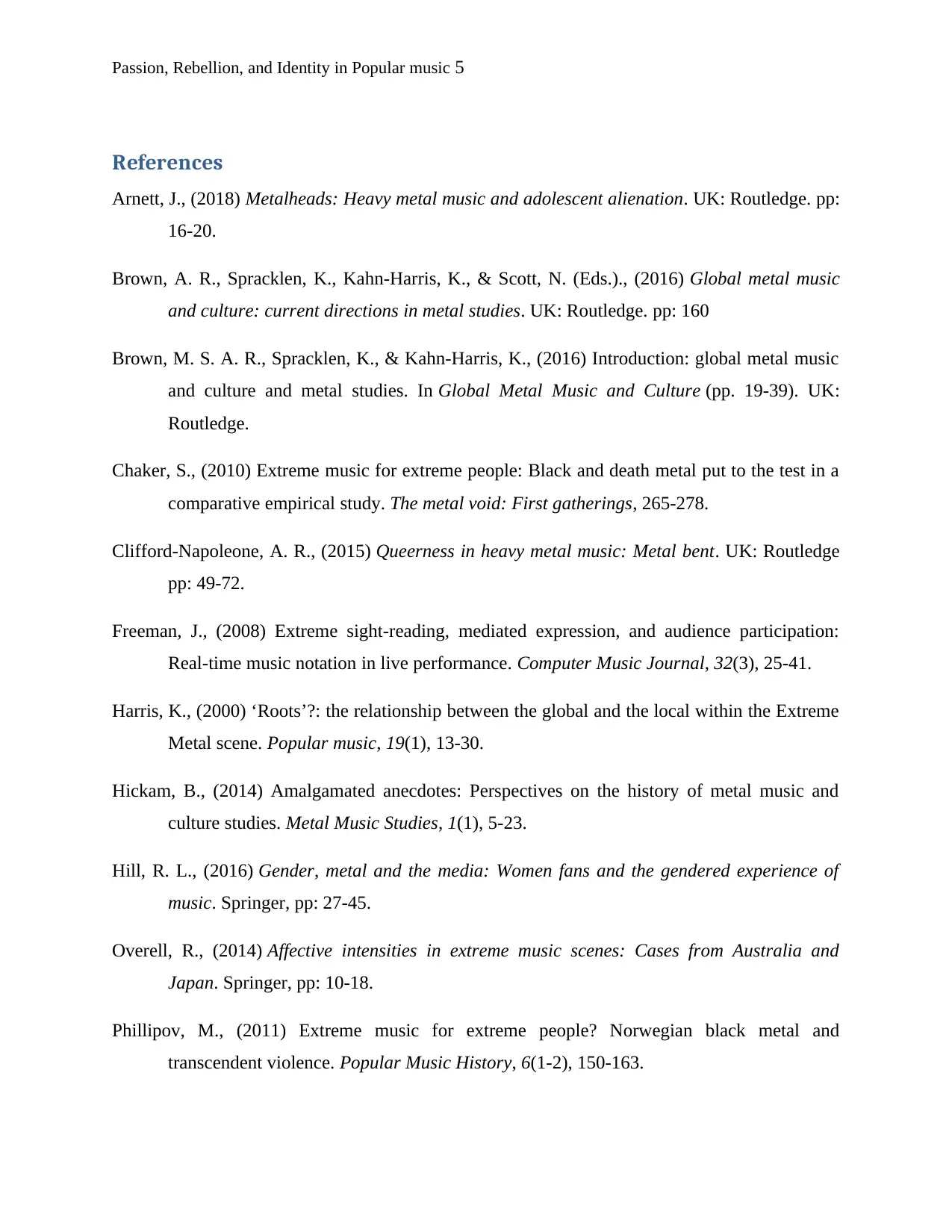
Passion, Rebellion, and Identity in Popular music 5
References
Arnett, J., (2018) Metalheads: Heavy metal music and adolescent alienation. UK: Routledge. pp:
16-20.
Brown, A. R., Spracklen, K., Kahn-Harris, K., & Scott, N. (Eds.)., (2016) Global metal music
and culture: current directions in metal studies. UK: Routledge. pp: 160
Brown, M. S. A. R., Spracklen, K., & Kahn-Harris, K., (2016) Introduction: global metal music
and culture and metal studies. In Global Metal Music and Culture (pp. 19-39). UK:
Routledge.
Chaker, S., (2010) Extreme music for extreme people: Black and death metal put to the test in a
comparative empirical study. The metal void: First gatherings, 265-278.
Clifford-Napoleone, A. R., (2015) Queerness in heavy metal music: Metal bent. UK: Routledge
pp: 49-72.
Freeman, J., (2008) Extreme sight-reading, mediated expression, and audience participation:
Real-time music notation in live performance. Computer Music Journal, 32(3), 25-41.
Harris, K., (2000) ‘Roots’?: the relationship between the global and the local within the Extreme
Metal scene. Popular music, 19(1), 13-30.
Hickam, B., (2014) Amalgamated anecdotes: Perspectives on the history of metal music and
culture studies. Metal Music Studies, 1(1), 5-23.
Hill, R. L., (2016) Gender, metal and the media: Women fans and the gendered experience of
music. Springer, pp: 27-45.
Overell, R., (2014) Affective intensities in extreme music scenes: Cases from Australia and
Japan. Springer, pp: 10-18.
Phillipov, M., (2011) Extreme music for extreme people? Norwegian black metal and
transcendent violence. Popular Music History, 6(1-2), 150-163.
References
Arnett, J., (2018) Metalheads: Heavy metal music and adolescent alienation. UK: Routledge. pp:
16-20.
Brown, A. R., Spracklen, K., Kahn-Harris, K., & Scott, N. (Eds.)., (2016) Global metal music
and culture: current directions in metal studies. UK: Routledge. pp: 160
Brown, M. S. A. R., Spracklen, K., & Kahn-Harris, K., (2016) Introduction: global metal music
and culture and metal studies. In Global Metal Music and Culture (pp. 19-39). UK:
Routledge.
Chaker, S., (2010) Extreme music for extreme people: Black and death metal put to the test in a
comparative empirical study. The metal void: First gatherings, 265-278.
Clifford-Napoleone, A. R., (2015) Queerness in heavy metal music: Metal bent. UK: Routledge
pp: 49-72.
Freeman, J., (2008) Extreme sight-reading, mediated expression, and audience participation:
Real-time music notation in live performance. Computer Music Journal, 32(3), 25-41.
Harris, K., (2000) ‘Roots’?: the relationship between the global and the local within the Extreme
Metal scene. Popular music, 19(1), 13-30.
Hickam, B., (2014) Amalgamated anecdotes: Perspectives on the history of metal music and
culture studies. Metal Music Studies, 1(1), 5-23.
Hill, R. L., (2016) Gender, metal and the media: Women fans and the gendered experience of
music. Springer, pp: 27-45.
Overell, R., (2014) Affective intensities in extreme music scenes: Cases from Australia and
Japan. Springer, pp: 10-18.
Phillipov, M., (2011) Extreme music for extreme people? Norwegian black metal and
transcendent violence. Popular Music History, 6(1-2), 150-163.
⊘ This is a preview!⊘
Do you want full access?
Subscribe today to unlock all pages.

Trusted by 1+ million students worldwide
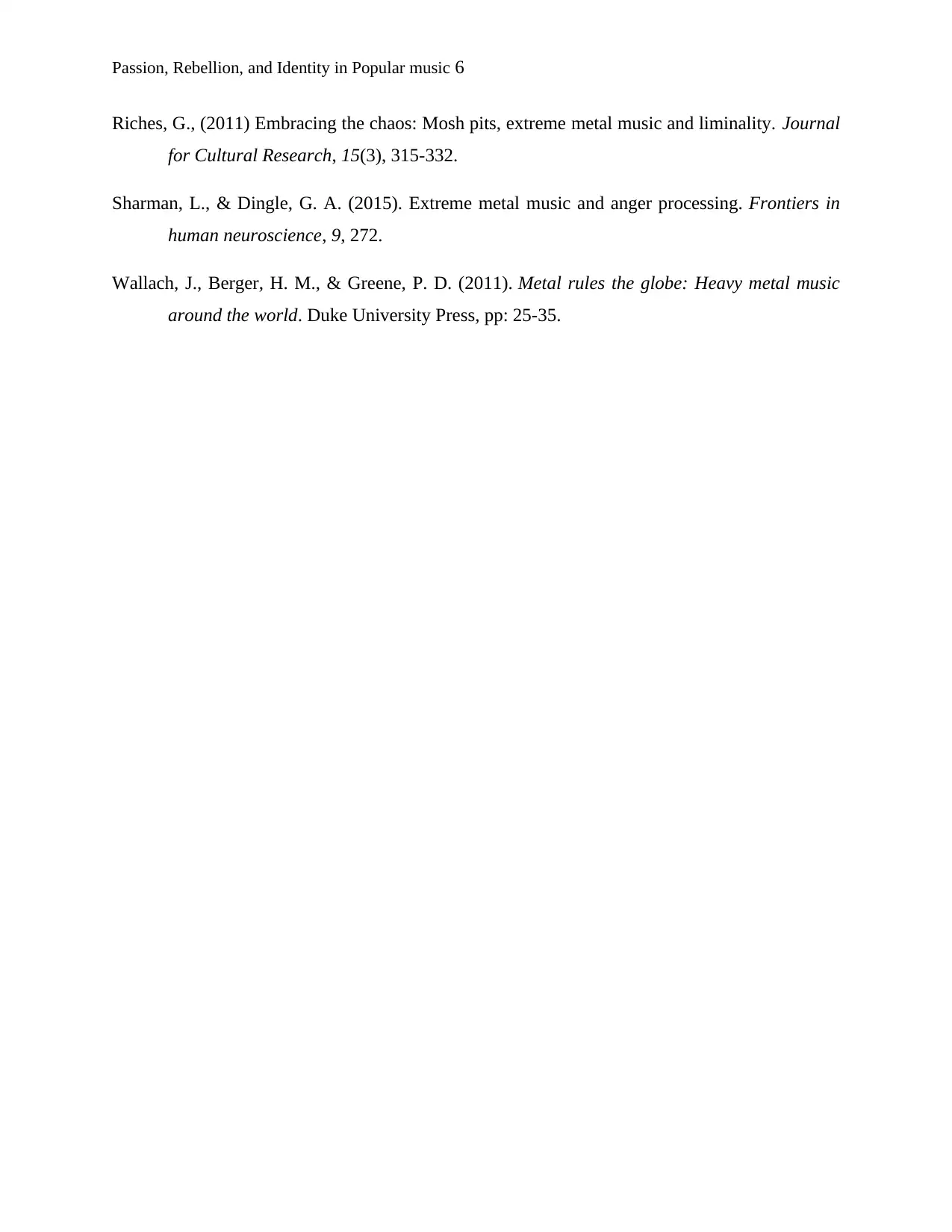
Passion, Rebellion, and Identity in Popular music 6
Riches, G., (2011) Embracing the chaos: Mosh pits, extreme metal music and liminality. Journal
for Cultural Research, 15(3), 315-332.
Sharman, L., & Dingle, G. A. (2015). Extreme metal music and anger processing. Frontiers in
human neuroscience, 9, 272.
Wallach, J., Berger, H. M., & Greene, P. D. (2011). Metal rules the globe: Heavy metal music
around the world. Duke University Press, pp: 25-35.
Riches, G., (2011) Embracing the chaos: Mosh pits, extreme metal music and liminality. Journal
for Cultural Research, 15(3), 315-332.
Sharman, L., & Dingle, G. A. (2015). Extreme metal music and anger processing. Frontiers in
human neuroscience, 9, 272.
Wallach, J., Berger, H. M., & Greene, P. D. (2011). Metal rules the globe: Heavy metal music
around the world. Duke University Press, pp: 25-35.
1 out of 7
Your All-in-One AI-Powered Toolkit for Academic Success.
+13062052269
info@desklib.com
Available 24*7 on WhatsApp / Email
![[object Object]](/_next/static/media/star-bottom.7253800d.svg)
Unlock your academic potential
Copyright © 2020–2025 A2Z Services. All Rights Reserved. Developed and managed by ZUCOL.
